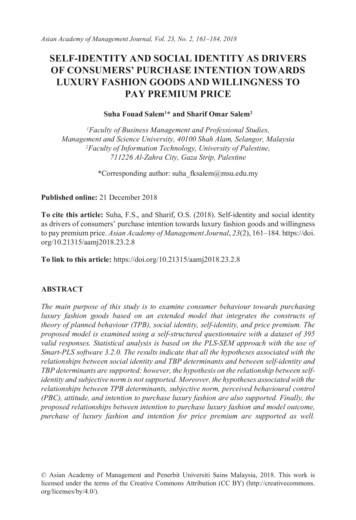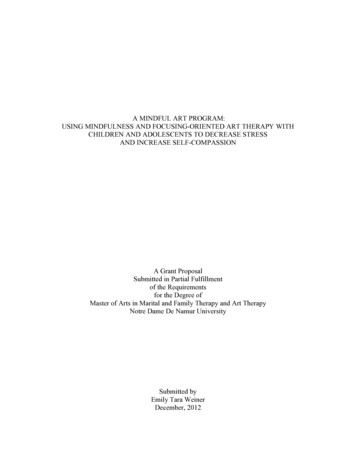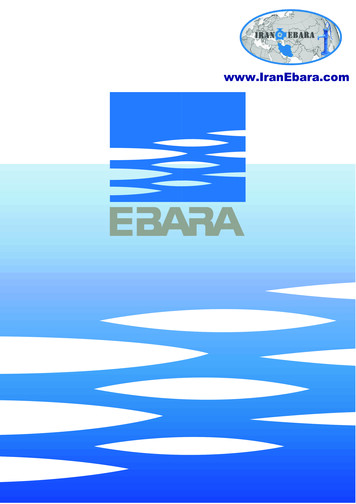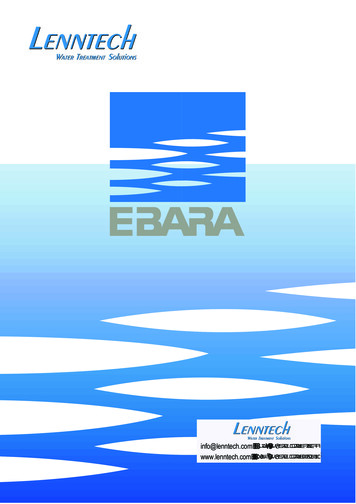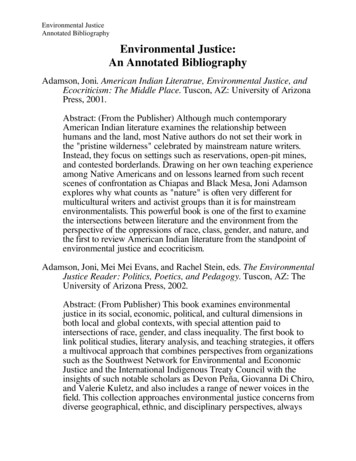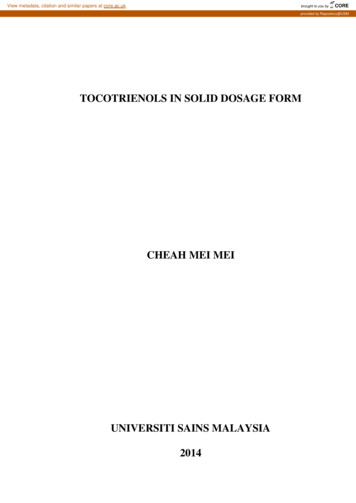
Transcription
View metadata, citation and similar papers at core.ac.ukbrought to you byCOREprovided by Repository@USMTOCOTRIENOLS IN SOLID DOSAGE FORMCHEAH MEI MEIUNIVERSITI SAINS MALAYSIA2014
TOCOTRIENOLS IN SOLID DOSAGE FORMbyCHEAH MEI MEIThesis submitted in fulfillment of the requirementsfor the degree ofMaster of ScienceJanuary 2014
To my parents, family members and close friendsii
ACKNOWLEDGEMENTSHere, I would like to express my utmost appreciation and sincere gratitude towardsmy academic supervisor, Professor Dr. Yuen Kah Hay for his invaluable advice,patience and guidance. Without his support and encouragement, I would not haveseen this project through. I would also like to thank Hovid Research Lab for theirgenerous supply of materials and for providing me a platform to conduct myresearch.I am equally grateful to Dr. Wong Jia Woei for all her constructive help and advice.To Sandy, Vanilla, Phaik Chin and Gan, I thank you from the very bottom of myheart. You were the ones who pushed and encouraged me to complete my studieseven when times were rough and I felt like giving up. To my other labmates; HooiYin, Lee Huang, Kam, Siew, Ying Yu, Luen Hui, Ai Boey, Fung Wai Yee,Kamaliah, Erena, Vijay, Kamarul, Belle, Song Thai, Yoghes, Enrico, Sheau Chin,Bee Hong, Choon Wai Yee, CMC, Yanti, Sin Yee, Syafiq and Jeremy, a big thankyou to all of you. You guys are simply the best and I will never forget the good andbad times we had together. To the others; Mr. Wan, En. Norshimi, and anyone elsewhom I may have missed out, thank you very much.I am also very thankful towards my family especially my parents for their unfailingsupport and encouragement.iii
TABLE OF BLE OF CONTENTSivLIST OF TABLESxiLIST OF FIGURESxivLIST OF EQUATIONSxviLIST OF SYMBOLSxviiLIST OF APPENDICESxixABSTRAKxxiiiABSTRACTxxvCHAPTER 1: INTRODUCTION1.1 Oral bioavailability of drugs11.2 Factors affecting the bioavailability of an oral drug11.2.1 Physiological factors11.2.1(a) Gastrointestinal pH21.2.1(b) The unstirred water layer21.2.1(c) Gastrointestinal membrane31.2.1(d) Pre-systemic metabolism41.2.1(e) Physiological disorders41.2.2 Physicochemical factors5iv
1.2.2(a) Solubility and permeability51.2.2(b) Stability of the drug51.2.2(c) Particle size and polymorphism of the drug61.2.3 Formulation factors71.3 Tocotrienols81.3.1 Introduction81.3.2 Pharmacokinetics of tocotrienols91.3.3 Potential health benefits101.3.3(a) Antioxidant properties101.3.3(b) Cholesterol lowering properties and prevention of10cardiovascular diseases1.3.3(c) Anti-cancer properties111.3.3(d) Diabetes and hypertension121.3.4 Current dosage form in the market121.4 Dosage forms131.4.1 Introduction131.4.2 Advantages of solid dosage forms131.5 Tocomax 20% powder141.6 Summary and scope of study15v
CHAPTER 2: IN VIVO EVALUATION OF TOCOMAX 20% POWDERVERSUS TWO DIFFERENT TOCOTRIENOLPREPARATIONS IN RATS2.1 Introduction162.1 Materials172.3 Methods172.3.1 Preparation of various tocotrienol preparations for administration17to the rats2.3.1(a) Preparation of Tocomax 20% powder182.3.1(b) Preparation of Tocovid Suprabio182.3.1(c) Preparation of Tocomin 50% oily formulation192.3.2 In vivo absorption studies192.3.3 Analysis of alpha, gamma and delta tocotrienols202.3.3(a) Instrumentation202.3.3(b) Sample preparation212.3.4 Data and pharmacokinetics analysis222.3.5 Statistical analysis232.4 Results242.5 Discussion332.6 Conclusion36CHAPTER 3: FORMULATION OF TABLETS USING TOCOMAX 20% POWDER AS ACTIVE3.1 Introduction37vi
3.2 Materials383.3 Methods383.3.1 Preparation of tablets with Tocomax 20% powder as the active38ingredient3.3.1(a) Usage of different types of diluents393.3.1(b) Usage of different types and amount of binders393.3.1(c) Usage of different types and amount of disintegrants423.3.1(d) Usage of different amount of lubricants423.3.1(e) Usage of different tablet sizes423.3.2 Tablet testing453.3.2(a) Appearance of tablets, physical defects and leaching of oil453.3.2(b) Disintegration453.3.2(c) Uniformity of weight453.3.3 Up-scale of tablets463.3.3.1 Additional test methods for up-scaled tablets463.3.3.1(a) Friability test463.3.3.1(b) Bulk density, tapped density tests and Carr’s47index3.3.3.1(c) Uniformity of content3.3.3.2 Adjustments to the up-scaled formulation48483.4 Results503.5 Discussion603.6 Conclusion63vii
CHAPTER 4: VALIDATION OF AN ASSAY METHOD FORTOCOMAX TABLETS4.1 Introduction644.2 Materials654.2.1 Chemicals and raw materials654.3 Methods654.3.1 High performance liquid chromatography (HPLC) method654.3.2 Validation of method used to assay tocotrienols in Tocomax65tablets4.3.2.1(a) Linearity654.3.2.1(b) Sample preparation for linearity study664.3.2.2(a) Specificity/ Selectivity664.3.2.2(b) Sample preparation for specificity/ selectivity study674.3.2.3(a) System suitability674.3.2.4(a) Recovery/ accuracy674.3.2.4(b) Sample preparation for recovery/ accuracy study684.3.2.5(a) Precision694.3.2.5(b) Sample preparation for precision study694.3.2.6(a) Stability of stock solution694.3.3 Quantification of tocotrienols in Tocomax704.3.3.1 Tocomax tablets704.3.3.2 Tablets kept at various storage conditions for 1, 2 and703 months4.4 Results71viii
4.4.1 Validation of the assay method714.4.1.1 Linearity714.4.1.2 Specificity/ Selectivity724.4.1.3 System suitability744.4.1.4 Recovery of drug solution from placebo tablets/ Accuracy744.4.1.5 Precision764.4.1.6 Stability of stock solution774.4.1 Quantification of tocotrienols in Tocomax tablets784.4.2.1 Tocomax tablet784.4.2.2 Tablets kept at various storage conditions for 1, 2 and 378months4.5 Discussion824.6 Conclusion84CHAPTER 5: DETERMINATION OF BIOAVAILABILITY OFTOCOMAX TABLETS IN HUMAN VOLUNTEERS5.1 Introduction865.2 Materials865.3 Methods865.3.1 Preparations of Tocomax Tablets and Tocomin oily formulation865.3.1(a) Preparation of Tocomax tablet875.3.1(b) Preparation of Tocomin oily formulation875.3.2 In vivo study protocol885.3.3 Analysis of alpha, gamma and delta tocotrienol905.3.3.1 Instrumentation90ix
5.3.3.2 Sample preparation905.3.4 Data and pharmacokinetic analysis915.3.5 Statistical analysis915.4 Results925.5 Discussion1005.6 Conclusion102CHAPTER 6: SUMMARY AND GENERAL CONCLUSION103CHAPTER 7: SUGGESTIONS FOR FUTURE WORK105REFERENCES107APPENDICES126CERTIFICATE OF ACKNOWLEDGEMENT149TURNITIN ORIGINALITY REPORT150x
LIST OF TABLESPAGE2.1Contents of each type of tocotrienol isomers in Tocomax 20%17powder (% w/w), Tocovid Suprabio (% w/v) and Tocomin 50%(% w/v)2.2The actual amount of tocotrienol isomer in each preparation182.3Sequence of administration of Tocomax 20% powder, Tocovid 20Suprabio and Tocomin 50% oily formulation2.4(a) Individual numerical values of AUC0-12h, Cmax, Tmax and the2890% confidence intervals for alpha tocotrienol after oraladministration of 5 mg per rat in the form of Tocomax 20%powder, Tocomin 50% oily formulation and Tocovid Suprabio2.4(b) Individual numerical values of AUC0-12h, Cmax, Tmax and the2990% confidence intervals for gamma tocotrienol after oraladministration of 5 mg per rat in the form of Tocomax 20%powder, Tocomin 50% oily formulation and Tocovid Suprabio2.4(c) Individual numerical values of AUC0-12h, Cmax, Tmax and the3090% confidence intervals for delta tocotrienol after oraladministration of 5 mg per rat in the form of Tocomax 20%powder, Tocomin 50% oily formulation and Tocovid Suprabio3.1Formulations of tablets with different types of diluents403.2Formulations of Tocomax 20% powder tablets with different41types and amount of binders3.3Formulations of tablets with different types and amount ofdisintegrants.xi43
3.4Formulations of tablets with different amount of lubricants.433.5Formulations of Tocomax 20% powder tablets with different44tablet sizes3.6Formulation of Tocomax 20% powder tablets for up-scale463.7Adjustment of ratios for Neusilin UFL2 and Neusilin US2.493.8Tablets produced using different diluents513.9Tablets produced using different types and amount of binders533.10Tablets produced using different types and amount of disintegrants553.11Tablets produced using different amount of lubricants553.12Tablets produced using different tablet sizes573.13Up-scaled batch of tablets and observations584.1The amount of individual tocotrienol isomers in the prepared66drug solutions4.2System Suitability of the 4.0 μg/ ml of Tocomin 50% injected74into the HPLC4.3Recovery of tocotrienols from Tocomax tablets754.4(a) Within day precision values of Tocomax tablet764.4(b) Between day precision values of Tocomax tablet774.5Stability of different tocotrienol isomers over a period of time775.1Individual amount of tocotrienol isomers and the total amount of87tocotrienols fed to each volunteer (tablets)5.2Individual amount of tocotrienol isomers and the total amount of88tocotrienols fed to each volunteer (capsules).5.3Biodata of the human volunteers895.4Sequence of administration of Tocomax tablet and Tocomin oily89xii
formulation5.5(a) Individual numerical values of AUC0-24h, Cmax, Tmax and the 90%96confidence intervals for alpha tocotrienol after dosing with Tocomaxtablets and Tocomin oily formulation (250 mg mixed tocotrienols),(Mean SEM, n 6)5.5(b) Individual numerical values of AUC0-24h, Cmax, Tmax and the 90%97confidence intervals for gamma tocotrienol after dosing with Tocomaxtablets and Tocomin oily formulation (250 mg, mixed tocotrienols),(Mean SEM, n 6)5.5(c) Individual numerical values of AUC0-24h, Cmax, Tmax and the 90%confidence intervals for delta tocotrienol after dosing with Tocomaxtablets and Tocomin oily formulation (250 mg mixed tocotrienols),(Mean SEM, n 6)xiii98
LIST OF FIGURESPAGE1.1Chemical structure of tocotrienols2.1(a) Mean plasma alpha tocotrienol concentration versus time profiles925after dosing with Tocomax 20% powder, Tocovid Suprabio andTocomin 50% oily formulation (Mean SEM, n 6)2.1(b) Mean plasma gamma tocotrienol concentration versus time profiles26after dosing with Tocomax 20% powder, Tocovid Suprabio andTocomin 50% oily formulation (Mean SEM, n 6)2.1(c) Mean plasma delta tocotrienol concentration versus time profiles27after dosing with Tocomax 20% powder, Tocovid Suprabio andTocomin 50% oily formulation (Mean SEM, n 6)3.1(a) Tablets without oil leakage upon compression523.1(b) Tablets with oil leaking out upon compression524.1Mean calibration curve of Tocomin 50% (n 6)714.2(a) Chromatogram of placebo tablet injected into the HPLC system724.2(b) Chromatogram of the mobile phase injected into the HPLC system734.2(c) Chromatogram of the 2.0 μg/ml of Tocomin 50%, showing the73peaks eluted out at 6.4 minutes (alpha tocotrienol), 5.7minutes (gamma tocotrienol) and 5.0 minutes (delta tocotrienol)4.3(a) Assay values of alpha tocotrienol in Tocomax tablets upon79storage at various conditions for duration of 3 months.4.3(b) Assay values of gamma tocotrienol in Tocomax tablets upon80storage at various conditions for duration of 3 months4.3(c) Assay values of delta tocotrienol in Tocomax tablets uponxiv81
storage at various conditions for duration of 3 months5.1(a) Mean plasma alpha tocotrienol concentration versus time profiles93after dosing with Tocomax tablets and Tocomin oilyformulation, 250 mg mixed tocotrienols (Mean SEM, n 6)5.1(b) Mean plasma gamma tocotrienol concentration versus time profiles94after dosing with Tocomax tablets and Tocomin oilyformulation, 250 mg mixed tocotrienols (Mean SEM, n 6)5.1(c) Mean plasma delta tocotrienol concentration versus time profilesafter dosing with Tocomax tablets and Tocomin oilyformulation, 250 mg mixed tocotrienols (Mean SEM, n 6)xv95
LIST OF EQUATIONSPAGE3.1Formula of bulk density473.2Formula of tapped density483.3Formula of Carr’s index484.1Assay of tocotrienols from tablets684.2Recovery of tocotrienols from tablets684.3Percentage of tocotrienols left in the drug solution70xvi
LIST OF SYMBOLS, ABBREVIATIONS OR NOMENCLATUREACNAcetonitrileANOVAAnalysis of varianceATPAdenosine triphosphateAUCArea under the plasma concentration-time curveAUC0-12hArea under the plasma concentration-time curve from time zero to thelast sampling time, 12 hours after dosingAUC0-24hArea under the plasma concentration-time curve from time zero to thelast sampling time, 24 hours after dosingCmaxPeak plasma concentrationCYP3A4Cytochrome P450 subfamily 3A4HPLCHigh performance liquid chromatographykeElimination rate constantMDRMultidrug resistantP-gpP-glycoproteinRCorrelation coefficientR.S.D.Relative standard deviationS.D.Standard deviationSEDDSSelf-emulsifying drug delivery systemS.E.M.Standard error of meanSESSelf-emulsifying systemTHFTetrahydrofuranTmaxTime to reach peak plasma concentrationxvii
USMUniversiti Sains Malaysiav/vvolume over volumew/wweight over weightw/vweight over volumexviii
LIST OF APPENDICESPAGE2.1Ethics committee approval letter1272.2(a) Plasma alpha tocotrienol concentration values of individual rat129after dosing with 5 mg of mixed tocotrienols containing 1.6 mgof alpha tocotrienol in the form of Tocomax 20% powder2.2(b) Plasma gamma tocotrienol concentration values of individual rat129after dosing with 5 mg of mixed tocotrienols containing 2.7 mgof gamma tocotrienol in the form of Tocomax 20% powder2.2(c) Plasma delta tocotrienol concentration values of individual rat129after dosing with 5 mg of mixed tocotrienols containing 0.7 mgof delta tocotrienol in the form of Tocomax 20% powder2.2(d) Plasma alpha tocotrienol concentration values of individual rat130after dosing with 5 mg of mixed tocotrienols containing 1.5 mgof alpha tocotrienol in the form of Tocovid Suprabio2.2(e) Plasma gamma tocotrienol concentration values of individual rat130after dosing with 5 mg of mixed tocotrienols containing 2.8 mg ofgamma tocotrienol in the form of Tocovid Suprabio2.2(f) Plasma delta tocotrienol concentration values of individual rat130after dosing with 5 mg of mixed tocotrienols containing 0.7 mgof delta tocotrienol in the form of Tocovid Suprabio2.2(g) Plasma alpha tocotrienol concentration values of individual ratafter dosing with 5 mg of mixed tocotrienols containing 1.6 mgxix131
of alpha tocotrienol in the form of Tocomin 50% oily formulation2.2(h) Plasma gamma tocotrienol concentration values of individual rat131after dosing with 5 mg of mixed tocotrienols containing 2.7 mgof gamma tocotrienol in the form of Tocomin 50% oily formulation2.2(i) Plasma delta tocotrienol concentration values of individual rat131after dosing with 5 mg of mixed tocotrienols containing 0.7 mgof delta tocotrienol in the form of Tocomin 50% oily formulation3.1(a) Appearance of Tocomax tablets with different types of diluents1323.1(b) Disintegration times of Tocomax tablets with different types of132diluents3.1(c) Uniformity of weight of Tocomax tablets with different types of132diluents3.2(a) Appearance of Tocomax tablets with different types and amount133of binders3.2(b) Disintegration times of Tocomax tablets with different types and133amount of binders3.2(c) Uniformity of weight of Tocomax tablets with different types and133amount of binders3.3(a) Appearance of Tocomax tablets with different types and134amount of disintegrants3.3(b) Disintegration times of Tocomax tablets with different types and134amount of disintegrants3.3(c) Uniformity of weight of Tocomax tablets with different types and134amount of disintegrants3.4(a) Appearance of Tocomax tablets with amount of lubricantxx135
3.4(b) Disintegration times of Tocomax tablets with different amount135of lubricant3.4(c) Uniformity of weight of Tocomax tablets with different amount135of lubricant3.5(a) Appearance of Tocomax tablets with different tablet sizes1363.5(b) Disintegration times of Tocomax tablets with different tablet136sizes3.5(c) Uniformity of weight of Tocomax tablets with different tablet136sizes3.6(a) Appearance of up-scaled Tocomax tablets1373.6(b) Disintegration times of up-scaled Tocomax tablets1373.6(c) Uniformity of weight of up-scaled Tocomax tablets1374.1(a) Individual drug solutions peak areas injected into the HPLC138system for linearity test4.1(b) Summary of the individual drug solution values and their138linearity, intercept and slope values for alpha, gamma and deltatocotrienols4.2Stability of drug solution when stored at room temperature for1392, 4, 6 and 8 hours4.3Individual assay values of Tocomax tablets when stored at140various storage conditions for 1, 2 and 3 months5.1Ethics committee approval letter for clinical studies1415.2Informed consent form of volunteers1435.3(a) Plasma alpha tocotrienol concentration values of individualvolunteer after dosing with 250 mg of mixed tocotrienolsxxi146
containing 60.6 mg of alpha tocotrienol in the form ofTocomax tablets5.3(b) Plasma gamma tocotrienol concentration values of individual146volunteer after dosing with 250 mg of mixed tocotrienolscontaining 102.5 mg of gamma tocotrienol in the form of Tocomaxtablets5.3(c) Plasma delta tocotrienol concentration values of individual147volunteer after dosing with 250 mg of mixed tocotrienolscontaining 27.5 mg of delta tocotrienol in the form of Tocomaxtablets5.3(d) Plasma alpha tocotrienol concentration values of individual147volunteer after dosing with 250 mg of mixed tocotrienolscontaining 61.6 mg of alpha tocotrienol in the form of Tocomin oily formulation5.3(e) Plasma gamma tocotrienol concentration values of individual148volunteer after dosing with 250 mg of mixed tocotrienolscontaining 103.0 mg of gamma tocotrienol in the form of Tocomin oily formulation5.3(f) Plasma delta tocotrienol concentration values of individualvolunteer after dosing with 250 mg of mixed tocotrienols containing26.6 mg of delta tocotrienol in the form of Tocomin oily formulationxxii148
TOKOTRIENOL DALAM DOS PEPEJALABSTRAKKajian biokeperolehan oral serbuk Tocomax 20% yang mengandungi campuranbeberapa jenis tokotrienol telah dijalankan dengan menggunakan tikus SpragueDawley. Kajian tersebut menunjukkan bahawa serbuk Tocomax 20% mempunyaibiokeperolehan yang separas dengan Tocovid Suprabio (1.0, 1.0 dan 1.2 kali gandauntuk alpha, gamma dan delta tokotrienol masing-masing). Di samping itu, ia jugamempunyai biokeperolehan yang lebih tinggi daripada suspensi minyak Tocomin 50% (1.9, 2.4 dan 2.9 kali ganda untuk alpha, gamma dan delta tokotrienol masingmasing).Penggunaan serbuk Tocomax 20% sebagai bahan aktif dalam formulasi tablet yangmengandungi tokotrienol menunjukkan bahawa tablet yang memuaskan dapatdihasilkan dengan menggunakan Neusilin UFL2 dan US2 sebagai diluents, Ac-DiSol sebagai disintegrant dan magnesium sebagai lubricant, dengan berat tabletsebanyak 500 mg setiap tablet. Tablet yang dihasilkan adalah sekata dari segi warnadan tidak mempunyai kecacatan seperti ‘capping’. Tablet tersebut juga mempunyaimasa peleraian yang baik, iaitu 8 minit dan mempunyai berat yang seragam (kurangdaripada 2%) Tablet dengan formulasi yang optimum juga berjaya dipindahkan keskala yang lebih besar.xxiii
Suatu kaedah kromatografi cecair prestasi tinggi yang digunakan untuk menentukankuantiti campuran tokotrienol dalam tablet disahkan berdasarkan garis panduan ICH.Kaedah asai itu dapat memuaskan criteria pengesahan dari segi ‘linearity’,kespesifikan, ketepatan dan kejituan. Kandungan tokotrienol dalam tablet yangdihasilkan adalah sebanyak 93.9, 92.6 dan 92.2% untuk alpha, gamma dan deltatokotrienol masing-masing. Eksperimen yang selanjutnya menunjukkan bahawatablet yang diformulasikan hanya stabil apabila disimpan dalam suhu 40C danbukannya apabila didedahkan kepada suhu 400C dan 70% RH (kelembapan relatif).Seterusnya, satu kajian biokeperolehan yang melibatkan sukarelawan manusiadijalankan dengan menggunakan tablet Tocomax yang telah dirumuskan dandibandingkan dengan suspensi minyak Tocomin . Profil biokeperolehan yangdidapati menunjukkan bahawa sukarelawan yang diberi tablet Tocomax adalah lebihtinggi daripada suspensi minyak Tocomin (2.0, 1.7 and 1.9 kali ganda untuk alpha,gamma dan delta tocotrienol masing-masing.xxiv
TOCOTRIENOLS IN SOLID DOSAGE FORMABSTRACTThe bioavailability study of Tocomax 20% powder containing mixed tocotrienolswas carried out using Sprague-Dawley rats. The study showed that Tocomax 20%powder had comparative oral bioavailability as the Tocovid Suprabio (1.0, 1.0 and1.2 times for alpha, gamma and delta tocotrienols respectively). In addition, it wasalso found to have better oral bioavailability as compared to Tocomin 50% oilyformulation (1.9, 2.4 and 2.9 times for alpha, gamma and delta tocotrienolrespectively).Subsequent usage of Tocomax 20% powder as the active ingredient for theformulation of tablets containing tocotrienols showed that a satisfactory tablet couldbe obtained using Neusilin UFL2 and US2 as the diluent, Ac-Di-Sol as thedisintegrant and magnesium stearate as the lubricant with the ideal tablet weight of500 mg per tablet. The tablets were homogeneous in colour and with no physicaldefects like capping. The tablets also have good disintegration times ofapproximately 8 minutes and were uniform in weight (less than 2%). The tablets withthe optimized formulation were also successfully up-scaled.A simple high performance liquid chromatography method used to assay the mixedtocotrienols in the tablets was validated in accordance with the ICH guidelines. Thexxv
method was found to fulfill validation requirements such as linearity, specificity,recovery/ accuracy and precision. The assay of the freshly prepared tablet was 93.9,92.6 and 92.2% for alpha, gamma and delta tocotrienols respectively. Furtherstability tests showed that the tablets were stable when kept at 40C but not at otherstorage conditions such as 400C and at 70% RH (relative humidity).Finally, a bioavailability study involving healthy human volunteers was carried outusing the formulated Tocomax tablets and compared against Tocomin oilyformulation. The profiles for volunteers given Tocomax tablets preparation obtainedwas consistently higher than that of the Tocomin oily formulation (2.0, 1.7 and 1.9times for alpha, gamma and delta tocotrienol respectively) when administered as thetablet compared to the oily formulation.xxvi
CHAPTER 1: INTRODUCTION1.1ORAL BIOAVAILABILITY OF DRUGSOral bioavailability of drugs is a term which is misconstrued by many as oral drugabsorption. It should be emphasized that while oral absorption involves the transit ofdrugs from the mucus membrane of the digestive tract into the blood stream, oralbioavailability, refers to the rate and amount of medication being moved from thedigestive tract to the intended site of action in the body (Ashford, 2002a, Chiou,2001).1.2FACTORS AFFECTING THE BIOAVAILABILITY OF AN ORAL DRUGThe oral route is the preferred mode of drug administration due to its ease andconvenience to the patients (Ashford, 2002a). Oral administration also avoids thepain and risk of infection associated with parenteral administrations such asintravenous and intramuscular injections (Gavhane and Yadav, 2012). However,many factors can affect the bioavailability of drugs given orally. Thus, anunderstanding of these factors is crucial in the development of an effective oralmedication (Muller et al., 2006). These factors can be classified into physiological,physicochemical and formulation factors.1.2.1PHYSIOLOGICAL FACTORSSome of the main physiological factors which may affect the oral bioavailabilityinclude gastrointestinal pH, the unstirred water layer, gastrointestinal (GI) membrane,pre-systemic metabolism and physiological disorders of the GI tract.1
1.2.1(a) Gastrointestinal pHThe pH of the gastrointestinal tract changes gradually from being acidic in thestomach region to being alkaline in the intestines and colon area (Fallingborg, 1999).The pH also differs between a fasting and a fed stomach (Ashford, 2002a). Sinceunionized drugs molecules penetrate the gastrointestinal membrane more effectivelythan ionized ones, a weakly acidic drug tend to have better absorption in the stomachwith more drug molecules existing as unionized forms while weakly basic drugs tendto have better absorption in the intestine (Schanker et al., 1957). The presence offood however, increases the pH of the gastrointestinal tract (Arne, 1978) andprolongs the gastric emptying (Jackson et al., 2007, Dressman et al., 1990). Theprolonged gastric emptying time increases the exposure time of the drug moleculesto the acidic stomach pH, leading to degradation of pH sensitive drugs such aspenicilins (Mizen et al, 1995, Simberkoff et al., 1970) and erythromycin (Cachet etal., 1989).1.2.1 (b) The unstirred water layerThe unstirred water layer is the region sandwiched between the lumen andgastrointestinal membrane. It comprises mainly mucus and glycocalyx (Ashford,2002a) and is approximately 500 μm thick (Atuma et al., 2000). While it offersprotection towards the gastrointestinal tract (Strugala et al., 2003), the layer has alsobeen shown to hinder the diffusion of certain drugs by binding the drugs to themucus and hence prevents them from crossing the gastrointestinal membrane(Loftsson and Brewster, 2011; MacAdam, 1993).2
1.2.1 (c) Gastrointestinal membraneThe gastrointestinal membrane, similar to a semi-permeable lipoidal sieve (Hogbenet al., 1959), is a barrier which allows only the passing of small molecules and ions(example, water molecules) through a convoluted passage between the epithelialcells lining the gastrointestinal membrane. This is known as the paracellular pathway(Gumbiner, 1987). The other route, transcellular pathway, involves the movement ofdrug molecules across the epithelial cells. Transcellular pathway can be sub-dividedinto various mechanisms such as passive diffusion and carrier mediated transport(Ashford, 2002a). While the passive diffusion route functions by transporting smalllipophilic molecules from a high concentration region to a low concentration region,the transportation of drugs with very hydrophilic molecules are restricted as they donot have sufficient lipid solubility to cross the gastrointestinal membrane (Adson etal., 1995). On the other hand, extremely hydrophobic drug molecules were unable tosolubilize in the aqueous layer of the gastrointestinal lumen before penetrating thegastrointestinal membrane. Carrier mediated transport, is further branched into twotypes, namely, active transport and facilitated diffusion (transport). Activetransportation involved the transportation of drug molecules against a concentrationgradient through the gastrointestinal membrane and it requires energy, generatedmainly from the hydrolysis of intracellular adenosine triphosphate (Komarova andMalik, 2010). In contrast, facilitated diffusion does not transfer drug moleculesagainst a concentration gradient, and thus, does not require energy. The substrates aretransported through facilitated diffusion down a concentration gradient at a ratebased on the molecular size and polarity of the molecule itself (Ashford, 2002a).3
1.2.1(d) Pre-systemic metabolismIntestinal P-glycoprotein (P-g) and intestinal metabolizing enzyme (CYP3A4) aretwo widely studied physiological factors that can affect the bioavailability of drugs(Ashford, 2002a). While P-gp (encoded by the MDR gene) exerts its effect byexpelling the drug out of the enterocytes (Juliano and Ling, 1976), CYP3A4 (apredominant Phase 1 drug metabolizing species found in humans), functions mainlyby metabolizing the drug before any effective absorption could take place(Koudriakova et al., 1998; Shimada et al., 1994). Both are believed to worksynergistically as the continuous process of expelling the drug into the lumen by theP-gp provided extra exposure for the CYP3A4 to metabolize the drug. P-gp alsoremoves metabolites from the enterocytes of the gastrointestinal tract and expelsthem back into the lumen, some of which are substrates of CYP3A4 (Hochman et al.,2000; Meijerman et al., 2008; Watkins, 1997). However, like most enzymes, both Pgp and CYP3A4 are saturable and can be inhibited (Sandström et al., 2001) orinduced (Lemahieu and Maes, 2007; Marzolini, 1994).1.2.1(e) Physiological disordersAging individuals were shown to undergo physiological changes (Newton, 2004),potentially altering drug metabolism as well as its pre-systemic elimination process(Wilkinson, 1997). Wilkinson (1997) also noted that patients with liver diseases(usually the elderly), often display signs of increased drug bioavailability, especiallydrugs which exhibit high first pass metabolism effects. The impaired hepatic functionreduces the extent of first pass metabolism, thus, increasing the oral bioavailability ofthe drug given. Other studies which discussed altered drug bioavailability due to4
diseases such as Parkinson and diabetes include those carried out by Seeberger andHauser (2007), Darwiche et al. (2001) and Hermann et al. (1998).1.2.2PHYSICOCHEMICAL FACTORSPhysicochemical factors refer to the properties of the drug molecule and theseinclude solubility and permeability, stability, particle size and polymorphism of thedrug (Hörter and Dressman, 2001).1.2.2(a) Solubility and permeabilityDrugs are classified into four classes under the Biopharmaceutics Drug ClassificationScheme (BCS). While Class I drugs are highly soluble and permeable, the remainingclasses of drugs faced either solubility, permeability or a combination of bothproblems (Martinez et al., 2002). Poor solubility of a drug will not only lead toundesirable drug precipitation (Dai, 2010), but will also produce drug solutions innano-molar concentrations in the gastrointestinal tract. With only trace amounts ofthe soluble drug and even lesser amount of drug being able to permeate the intestinalbarrier, the oral bioavailability of the drug administered is reduced and therefore,insufficient to induce a therapeutic effect on the patient (Bergstrom et al., 2004).1.2.2(b) Stability of the drugT
Suprabio and Tocomin 50% oily formulation 2.4(a) Individual numerical values of AUC 0-12h, C max, T max and the 28 90% confidence intervals for alpha tocotrienol after oral administration of 5 mg per rat in the form of Tocomax 20% powder, Tocomin 50% oily formulation and Tocovid Suprabio 2.4(b) Individual numerical values of AUC 0-12h .


